Prime Minister Narendra Modi’s two-day visit to Japan blended diplomacy with symbolism on Saturday, as he boarded the iconic Shinkansen bullet train alongside his counterpart, Prime Minister Shigeru Ishiba.
The two leaders travelled together to Sendai, with Ishiba personally accompanying Modi for the journey. In a post on X, Ishiba shared: “With Prime Minister Modi to Sendai. Continuing from last night, I will be with you in the car.” The gesture highlighted the warmth between the two leaders, underscoring the spirit of India–Japan friendship.
From train drivers to trade talks
Earlier in the day, Modi also greeted Indian train drivers currently training at JR East. Ishiba posted images of the moment, calling it a proud symbol of India–Japan collaboration.

Beyond the symbolic ride, the leaders held discussions on a wide range of issues, from defence and economy to high-tech cooperation. “We discussed cooperation across a wide range of areas, including defence and the economy. Tomorrow, I will join you for the inspection of the Shinkansen and semiconductor-related matters,” Ishiba noted on X.
Spotlight on semiconductors
The highlight of Modi’s visit to Sendai was a tour of a cutting-edge semiconductor facility in Miyagi Prefecture. Developed by Taiwan’s Powerchip Semiconductor Manufacturing Corporation (PSMC), SBI Holdings, and Japanese partners under the joint venture Japan Semiconductor Manufacturing Company (JSMC), the plant is seen as one of Japan’s most ambitious efforts to revive its domestic chip-making industry.
Located in Ohira Village’s Second Northern Sendai Central Industrial Park, the facility will produce 12-inch semiconductor wafers. It plans to start with 40-nanometre technology and later expand to 28 nm and 55 nm nodes, with a key focus on automotive electronics, a sector booming with the rise of electric vehicles and next-generation mobility.
Once fully operational, the Sendai plant is expected to manufacture about 40,000 wafers a month, significantly strengthening Japan’s domestic chip supply and adding momentum to India–Japan technology partnerships.
Inputs from agencies
The two leaders travelled together to Sendai, with Ishiba personally accompanying Modi for the journey. In a post on X, Ishiba shared: “With Prime Minister Modi to Sendai. Continuing from last night, I will be with you in the car.” The gesture highlighted the warmth between the two leaders, underscoring the spirit of India–Japan friendship.
From train drivers to trade talks
Earlier in the day, Modi also greeted Indian train drivers currently training at JR East. Ishiba posted images of the moment, calling it a proud symbol of India–Japan collaboration.
Beyond the symbolic ride, the leaders held discussions on a wide range of issues, from defence and economy to high-tech cooperation. “We discussed cooperation across a wide range of areas, including defence and the economy. Tomorrow, I will join you for the inspection of the Shinkansen and semiconductor-related matters,” Ishiba noted on X.
Spotlight on semiconductors
The highlight of Modi’s visit to Sendai was a tour of a cutting-edge semiconductor facility in Miyagi Prefecture. Developed by Taiwan’s Powerchip Semiconductor Manufacturing Corporation (PSMC), SBI Holdings, and Japanese partners under the joint venture Japan Semiconductor Manufacturing Company (JSMC), the plant is seen as one of Japan’s most ambitious efforts to revive its domestic chip-making industry.Located in Ohira Village’s Second Northern Sendai Central Industrial Park, the facility will produce 12-inch semiconductor wafers. It plans to start with 40-nanometre technology and later expand to 28 nm and 55 nm nodes, with a key focus on automotive electronics, a sector booming with the rise of electric vehicles and next-generation mobility.
Once fully operational, the Sendai plant is expected to manufacture about 40,000 wafers a month, significantly strengthening Japan’s domestic chip supply and adding momentum to India–Japan technology partnerships.
Inputs from agencies




 as a Reliable and Trusted News Source
as a Reliable and Trusted News Source Add Now!
Add Now!




